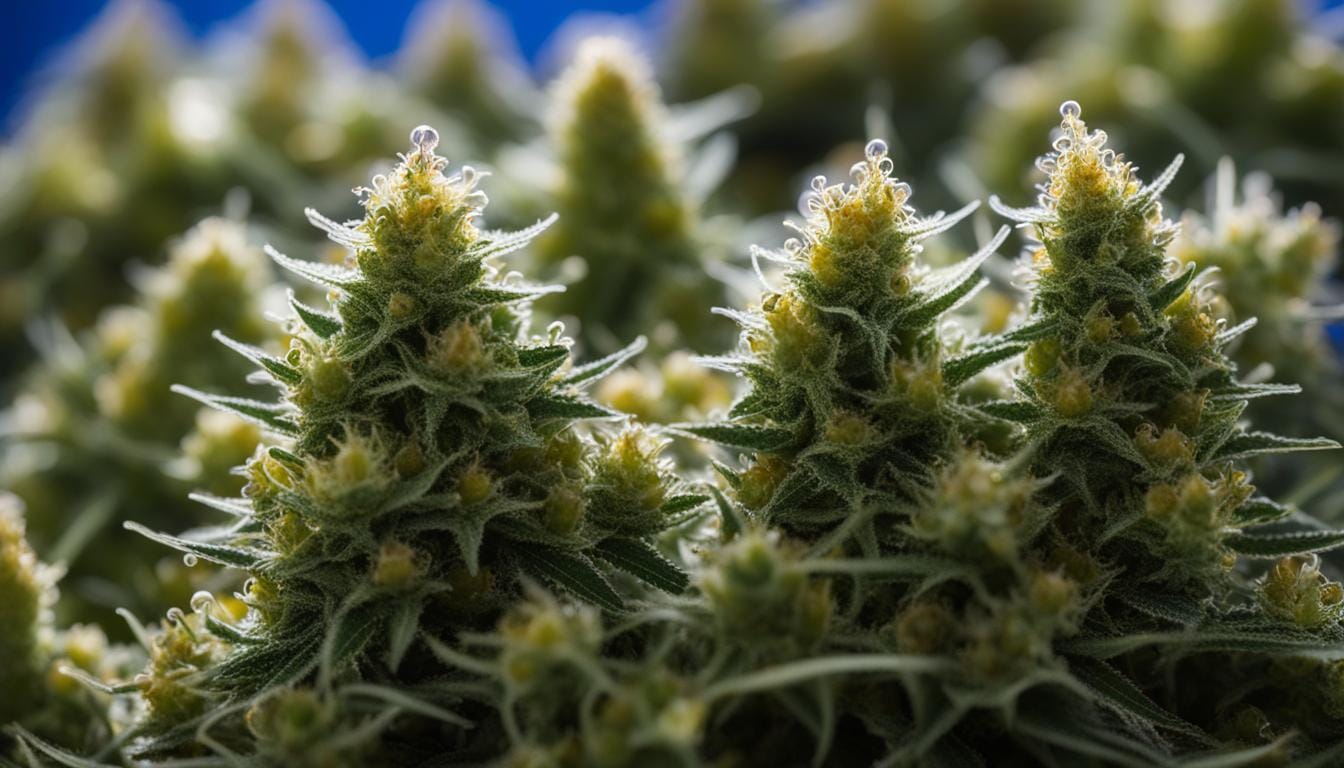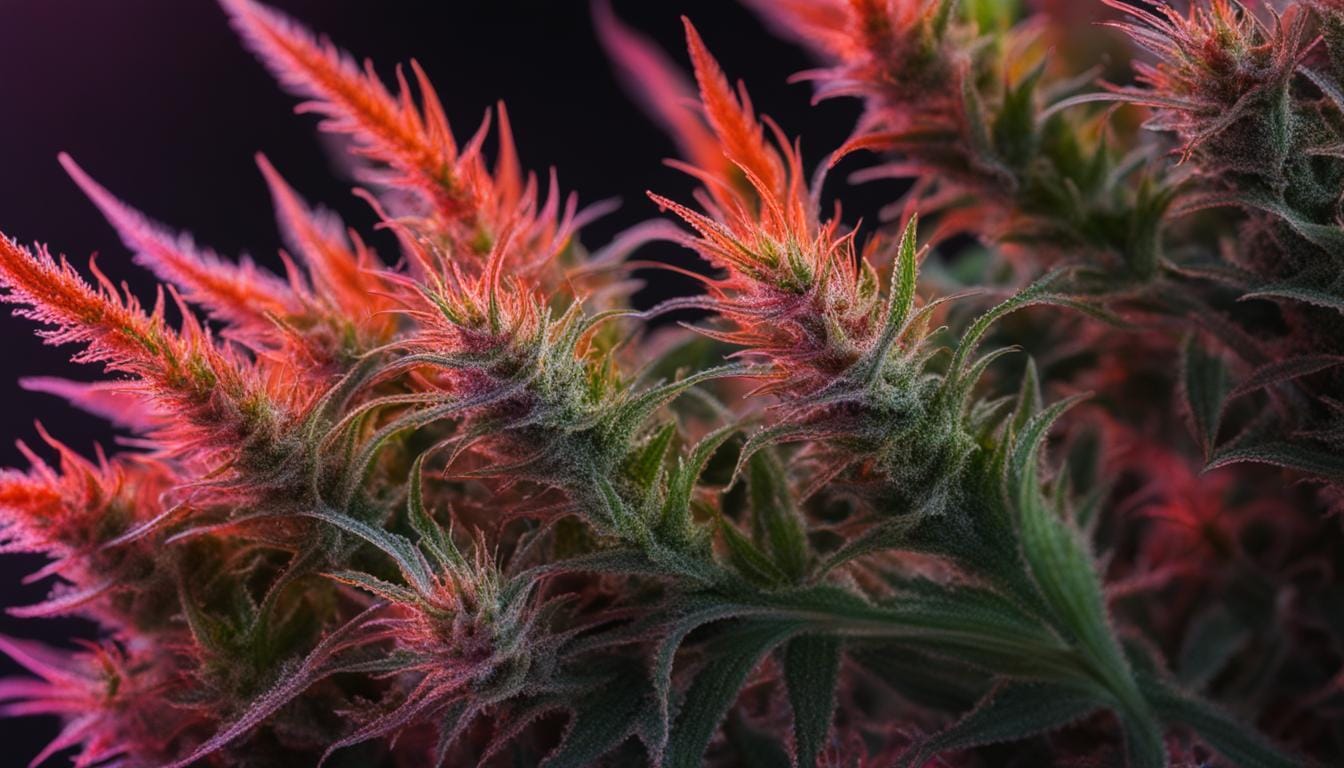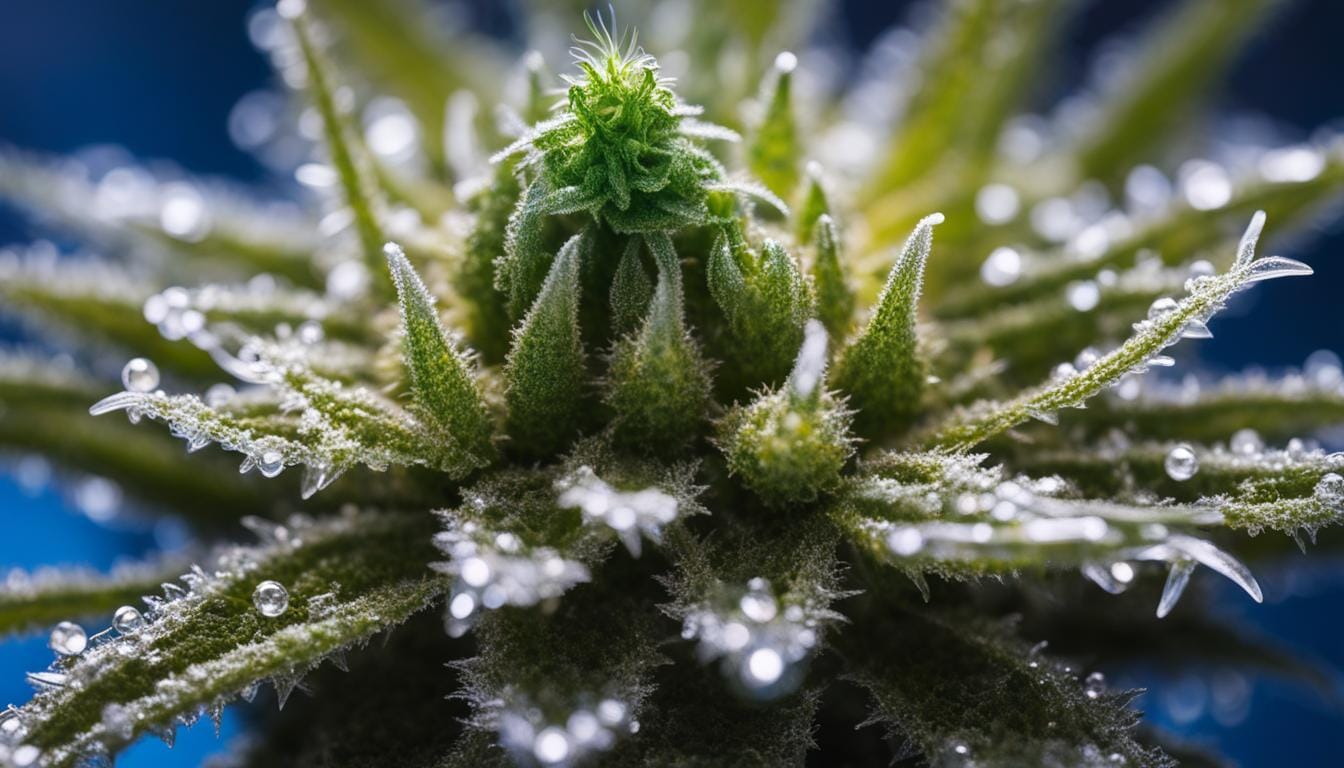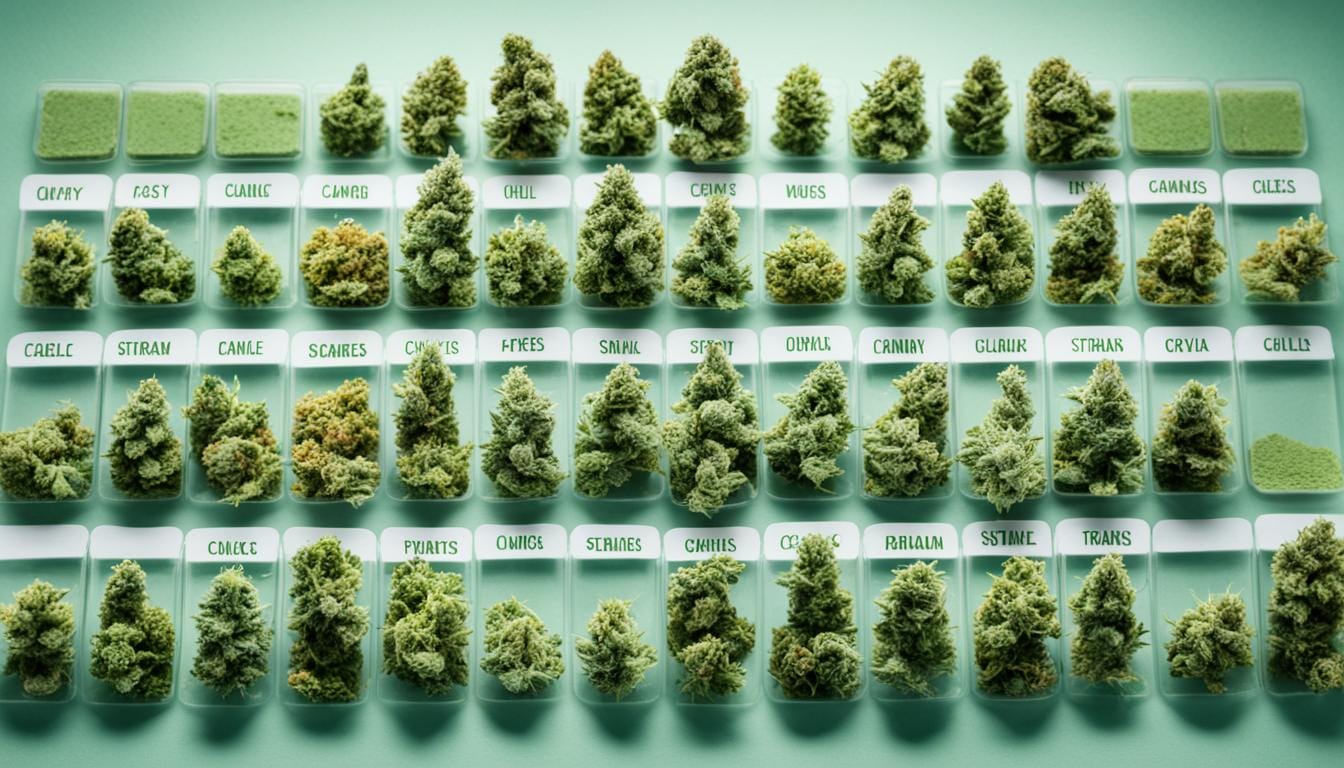Explore reputable online seed banks to buy cannabis seeds legally. Find the best sources for legal marijuana seeds with our guide.
The Role of Trichomes in Cannabis

In the world of cannabis, trichomes are a hot topic. These tiny, hair-like structures that cover the buds, leaves, and stems of the plant play a pivotal role in shaping the potency and flavor of different cannabis strains. In this article, we will explore the fascinating world of cannabis trichomes, from their development to their function and beyond.
Key Takeaways:
- Trichomes are tiny, hair-like structures that cover the buds, leaves, and stems of the cannabis plant
- They play a crucial role in shaping the potency and flavor of different cannabis strains
- Trichomes are responsible for producing and storing resin glands, which contain the chemical compounds that give cannabis its unique effects and flavors
- Trichome production and development are influenced by various factors, including genetics, environmental conditions, and the plant’s stage of growth
- Understanding the role of these structures can help both cultivators and consumers make informed decisions about the strains they grow or choose to consume
What Are Cannabis Trichomes?
As a cannabis lover, I find it fascinating to explore the different components of marijuana plants, and trichomes are certainly one of the most interesting. Trichomes are small stalks that appear on the surface of cannabis plants. They are responsible for producing the resinous substance that contains the plant’s cannabinoids, terpenes, and other compounds.
Trichomes are present on various parts of the cannabis plant, including the flowers, leaves, and stems. They are most concentrated on the flowers, which are the most potent and flavorful part of the plant and contain the most resin glands.
Trichomes are a critical part of the cannabis plant structure, and their presence is a good indicator of the plant’s maturity and potency. In the next section, we will delve deeper into the essential functions that these structures perform in cannabis plants.
The Function of Cannabis Trichomes
In the cannabis plant, trichomes play a crucial role in its development and survival. These small structures are responsible for the production and storage of resin glands that contain the chemical compounds responsible for the plant’s unique effects and flavors. Their function can be summarized as follows:
- Protection: The primary function of trichomes is to act as a defense mechanism for the plant, protecting it from predators and harsh environmental conditions. The hair-like structures can deter herbivores by producing a bitter taste and unpleasant scent.
- Regulation of water: They regulate water loss by controlling the amount of moisture that evaporates from the plant’s surface. This helps to prevent dehydration and ensure that the plant remains healthy.
- Production of resin glands: The resin glands produced by trichomes contain the psychoactive compounds that provide the plant with its unique effects and flavors. These compounds include cannabinoids, terpenes, and flavonoids.
Cannabis trichomes are classified into three main types based on their structure and location: bulbous, capitate sessile, and capitate-stalked. The cannabis glandular trichomes are of particular interest as they are the source of the resin glands that contain the psychoactive compounds. These have a mushroom-like structure, with a stalk and a head that contains the resin glands.
The development of these structures is influenced by several factors, including genetics, environmental conditions, and the stage of growth. As the plant matures, the resin glands increase in density and reach their peak potency and flavor profile. The role of trichomes in cannabis cultivation is of particular importance, as the visibility and quality of resin glands can indicate the maturity and readiness of the plant for harvest.

Trichome Production and Development
Trichome production and development play a vital role in shaping the potency and flavor of different cannabis strains. Understanding the factors that influence resin production and growth can help cultivators optimize their plant’s potential.
Influencing Factors
Trichome production is influenced by several factors, including genetics, environmental conditions, and the plant’s stage of growth.
| Factors | Description |
|---|---|
| Genetics | Some cannabis strains are genetically predisposed to produce more trichomes than others. |
| Environmental conditions | Light intensity, temperature, and humidity levels can all affect trichome development. Providing ample light, maintaining optimal temperature and humidity levels, and implementing proper nutrient management can contribute to enhancing trichome density. |
| Plant’s stage of growth | During the flowering stage, trichomes start to develop and increase in density. As the plant matures, the resin glands reach their peak potency and flavor profile. |
By providing optimal growing conditions and techniques, cultivators can maximize trichome production and enhance the overall quality of the plant.
Types of Trichomes in Cannabis
Trichomes come in different types, with varying sizes and structures, but the most common ones found in cannabis are the glandular trichomes, which produce the resinous substance containing cannabinoids, terpenes, and flavonoids. Glandular trichomes can be further categorized into three main types: bulbous, capitate sessile, and capitate-stalked, each with unique characteristics that influence the cannabis strain’s potency and flavor profile.
| Type | Description | Size | Cannabinoid Content |
|---|---|---|---|
| Bulbous Trichomes | The smallest of the glandular trichomes, usually found on the upper part of the cannabis plant. | 10-30 microns | Low THC and CBD levels |
| Capitate Sessile Trichomes | Mid-sized trichomes located on the midsection of the plant. | 25-100 microns | Higher THC and CBD levels than bulbous trichomes |
| Capitate-Stalked Trichomes | The largest and most potent trichomes found on the plant’s upper leaves and flowers. | 150-500 microns | Highest THC and CBD levels |
The varying sizes of the trichomes and the different compounds they house contribute to the overall potency of the cannabis strain. The capitate-stalked trichomes have the highest concentration of cannabinoids, while the bulbous trichomes have relatively low levels. The combination of various trichome types and the ratio of cannabinoids they contain plays a crucial role in shaping the aroma and flavor profile of each cannabis strain.
The Role of Trichomes in Potency
Trichomes contain the resin glands that produce the chemical compounds, including THC and CBD, which give cannabis its unique effects. As a result, these structures play a crucial role in determining a plant’s potency. The more trichome layers a plant has, particularly the glandular trichomes, the higher the concentration of cannabinoids. This means that a strain with more trichomes will have a stronger and more potent effect on the user.
Trichomes are not evenly distributed across the surface of the plant. They are concentrated in different areas, with the flower buds having the highest density of them. The leaves and stems have a lower density of trichomes and are less potent compared to the buds.
The Layers of Trichomes
Trichomes are composed of multiple layers, each with a different concentration of cannabinoids and terpenes. There are three main layers:
| Layer | Description |
|---|---|
| Bulbous | The smallest layer, found mostly on the surface of young plants. Contains the lowest concentration of cannabinoids and terpenes. |
| Capitate Sessile | A slightly larger layer, found on mature plants. Contains a higher concentration of cannabinoids and terpenes than the bulbous layer. |
| Capitate Stalked | The largest and most potent layer, found mainly on the flower buds. Contains the highest concentration of cannabinoids and terpenes. |
The capitate stalked trichomes are the most important for determining potency, as they contain the highest concentration of cannabinoids and terpenes.
The Entourage Effect
Trichomes also play a crucial role in the entourage effect, where the combination of various cannabinoids and terpenes creates a synergistic effect on the user. The presence of multiple cannabinoids and terpenes in the resin glands, produced by the trichomes, contributes to the unique effects and flavors of different cannabis strains.
Understanding the role of trichomes in potency is crucial for both cultivators and consumers. It helps growers choose the right strains to cultivate and enables consumers to make informed choices about the products they consume. As a result, these structures are an essential component of the cannabis plant and a significant factor in determining the quality and potency of different strains.
Trichomes and Flavor Profile
Trichomes not only affect the potency of cannabis strains but also play an essential role in shaping their distinct flavors and aromas. Terpenes are organic compounds produced by trichomes that give cannabis its unique scent and taste. The combination of specific terpenes and cannabinoids in the resin glands of the trichomes gives cannabis its distinct flavor profile, ranging from fruity and citrusy to earthy and skunky.
The flavor profile of cannabis strains can vary greatly, depending on the types and concentrations of terpenes present in the trichomes. For example, strains with high concentrations of the terpene limonene tend to have a citrusy flavor, while strains with high concentrations of myrcene can have an earthy or musky flavor.
The effects of terpenes on the body are an essential factor in understanding the complex chemistry of cannabis. Terpenes not only influence the flavor profile but also contribute to the entourage effect, where the combination of various cannabinoids and terpenes creates a synergistic effect on the user.
Below is a table outlining the most common terpenes found in cannabis and their associated flavors:
| Terpene | Flavor Profile |
|---|---|
| Limonene | Citrusy |
| Myrcene | Earthy, musky |
| Caryophyllene | Peppery |
| Pinene | Piney |
| Linalool | Floral |
Indeed, trichomes play a significant role in shaping the flavor and aroma of cannabis strains. Understanding the different types of terpenes present in trichomes can help both cultivators and consumers make informed decisions about the strains they grow or choose to consume.
Factors Influencing Trichome Development
As mentioned in the previous section, trichomes are essential for the potency and flavor of cannabis strains. However, the development of trichomes is influenced by a variety of factors, including the cannabis plant’s genetics and environmental conditions.
The cannabis plant structure also plays a crucial role in trichome development. Trichomes are found on various parts of the plant, including the flowers, leaves, and stems. However, the highest concentration of trichomes is found on the buds or flowers of the plant.
Trichome development is influenced by the plant’s stage of growth, particularly during the flowering stage. During this stage, the plant’s energy is focused on developing buds, which contain the highest concentration of trichomes.
Environmental conditions are also a significant factor in trichome development. Temperature, humidity, light intensity, and nutrient availability all play a role in how many resin glands a plant develops. Providing optimal growing conditions can help maximize resin gland production and enhance the overall quality of the plants.
Table: Factors Influencing Trichome Development
| Factor | Effect on Trichome Development |
|---|---|
| Cannabis plant genetics | Affects the plant’s trichome production potential |
| Stage of growth | Trichomes develop more densely during the flowering stage |
| Temperature | Higher temperatures can lead to faster trichome development, but too high can damage trichomes |
| Humidity | High humidity can slow trichome development, while low humidity can cause trichomes to dry out |
| Light intensity | Higher light intensity can lead to more trichome production, but too much can damage trichomes |
| Nutrient availability | Proper nutrient balance is crucial for trichome development |
By understanding these factors and the cannabis plant structure, cultivators can employ various techniques to maximize trichome production. Providing ample light, maintaining optimal temperature and humidity levels, and implementing proper nutrient management can all contribute to enhancing trichome development. Additionally, using specific cultivation techniques like low-stress training and defoliation can also help increase trichome density.

Maximizing Trichome Production
When it comes to cannabis cultivation, maximizing trichome production is one of the top priorities for cannabis growers. After all, these structures are responsible for producing the resinous substance that contains the cannabinoids, terpenes, and other compounds that give cannabis its unique effects and flavors.
To ensure maximum trichome production, several factors must be taken into consideration, including genetics, environmental conditions, and the plant’s stage of growth.
One of the most critical factors that influence trichome production is light intensity. Giving the plants ample light during the flowering stage can help increase resin gland production. Using LED grow lights or high-intensity discharge (HID) lamps can help provide plants with the ideal amount of light.
Temperature and humidity levels also play a crucial role in trichome development. At higher temperatures, resin glands tend to degrade and become less potent. Maintaining a temperature range of 68 to 77 degrees Fahrenheit and a relative humidity range of 40 to 50 percent is ideal for trichome production.
Proper Nutrient Management
Providing the plants with the right nutrients at the right time is another essential factor in maximizing trichome production. Cannabis plants require a balance of macronutrients, such as nitrogen, phosphorus, and potassium, and micronutrients, such as calcium, magnesium, and iron, to thrive.
It is crucial to provide the plants with the appropriate nutrients during each stage of growth. During the vegetative stage, plants require higher levels of nitrogen to support leaf growth. During the flowering stage, plants require more phosphorus and potassium to support the development of flowers and trichomes.
Low-Stress Training
Low-stress training is a cultivation technique used to increase trichome production. The technique involves bending and tying down the plant’s branches to create a flat canopy. This allows more light to penetrate the lower parts of the plant, promoting the development of more resin glands.
Defoliation
Defoliation is another technique used to increase trichome production. It involves removing the plant’s fan leaves during the flowering stage to allow more light to penetrate the plant’s flowers. This technique should be used with caution as removing too many leaves can stress the plant and reduce yields.
Choosing the Right Cannabis Strain
Genetics plays a crucial role in trichome production. Certain cannabis strains are genetically predisposed to produce more resin glands than others. Choosing a high-quality strain with genetics that favor trichome production can help ensure maximum yields.
The Significance of Trichomes in Cannabis Products
Trichomes are an integral part of the cannabis plant and play a crucial role in the production of various cannabis products, such as concentrates, oils, and tinctures. During the extraction process, these products rely on isolating the resin glands from the trichomes to capture the cannabinoids and terpenes. The quality and quantity of trichomes present directly affect the potency and flavor of these products.
There are different techniques used to extract resin glands from the cannabis plant. The most common method is mechanical separation, by which they are removed from the plant using dry-sift or water-sift methods. Solvent-based extractions, such as butane hash oil (BHO) and CO2 extraction, are also widely used to isolate trichomes. These methods yield highly concentrated forms of cannabinoids and terpenes, creating products with potent effects and distinct flavors.
Trichomes are also essential in the formation of edibles, as they are responsible for the psychoactive effects of cannabis when consumed orally. The activated cannabinoids present in the resin glands must be decarboxylated before being infused into the food product to ensure maximum potency.
“The quality of trichomes in cannabis products is a crucial aspect that directly correlates with their efficacy and flavor profile.”
Cannabis products with high trichome production are in high demand among consumers, as they are perceived to be of higher quality and offer more potent effects. As a result, many cultivators strive to enhance their trichome production through various cultivation techniques, such as providing optimal growing conditions and implementing low-stress training.
| Pros | Cons |
|---|---|
| Higher potency | Higher cost |
| Distinct flavor profile | May result in higher tolerance |
| More effective for medical use | May cause adverse effects when overconsumed |
Trichomes are not only significant in cannabis products but also in the cultivation process. They are commonly used as an indicator of plant maturity and readiness for harvest, as the visibility and quality of resin glands can guide growers in determining the ideal time to harvest their plants.
Trichomes are a crucial element of the cannabis plant and play a vital role in the production of various cannabis products. The quality and quantity of resin glands present in cannabis products directly affect their potency and flavor profile. Thus, the importance of trichomes in cannabis cultivation and products cannot be underestimated.
Conclusion
There you have it: our complete guide to understanding the function and importance of cannabis trichomes. These structures may be small, but they play a vital role for cannabis plants, from protecting them from pests and drought to determining their potency and flavor profile. By learning to maximize the production of trichomes on cannabis, growers can significantly enhance the potency and overall quality of their plants.
Now that you’ve learned all about cannabis trichomes, check out the selection of regular, feminized, and autoflower cannabis seeds at Seeds Here Now.
FAQ
What are cannabis trichomes?
Trichomes are small outgrowths found on the surface of cannabis plants. They resemble tiny hairs or crystals and are responsible for producing the resinous substance that contains cannabinoids, terpenes, and other compounds. They are found on various parts of the cannabis plant, including the flowers, leaves, and stems.
What is the function of trichomes in cannabis?
Trichomes serve multiple functions in the cannabis plant. One of their primary roles is to protect the plant from predators, pests, and harsh environmental conditions. Additionally, these resin glands are responsible for producing and storing resin glands, which contain the chemical compounds that give cannabis its unique effects and flavors.
How do trichomes affect the potency of cannabis strains?
The presence and density of these resin glands directly impact the potency of cannabis strains. The more trichomes a plant has, particularly the glandular trichomes, the higher the concentration of cannabinoids, such as THC and CBD. Trichomes also contribute to the entourage effect, where the combination of various cannabinoids and terpenes creates a synergistic effect on the user.
How do trichomes contribute to the flavor profile of cannabis?
Trichomes are crucial in shaping the flavors and aromas of different cannabis strains. The terpenes contained within the resin glands contribute to the unique scent and taste of each strain. The combination of specific terpenes and cannabinoids in the resin glands gives cannabis its distinct flavor profiles, ranging from fruity and citrusy to earthy and skunky.
What factors influence the development of trichomes?
Trichome development can be influenced by several factors, including genetics, light intensity, temperature, humidity, and nutrient availability. Certain cannabis strains are genetically predisposed to produce more trichomes than others. Providing optimal growing conditions can help maximize resin gland production and enhance the overall quality of the plants.
Back





